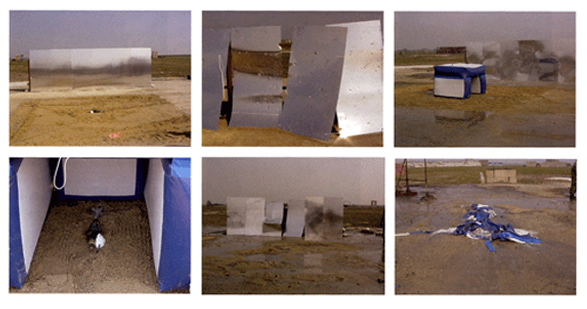 The ordnance disposal blast bin works in a similar way to the Isolation Bin except that the design has been optimised for use by specialist Explosive Ordnance Disposal Crews working on live ordnance disposal on military training areas or in post conflict scenarios.
The ordnance disposal blast bin works in a similar way to the Isolation Bin except that the design has been optimised for use by specialist Explosive Ordnance Disposal Crews working on live ordnance disposal on military training areas or in post conflict scenarios.
The system is currently deployed by the British Army and being evaluated by the United States Corps of Engineers and the Hong Kong Police and elsewhere. The Blast Bins can be deployed and inflated in under 5 minutes and are capable of suppressing fragmentation arising from most battlefield munitions removing the need to build time consuming sandbag or sand-filled enclosures.
In a test undertaken on behalf of the UK MoD, an 81mm mortar was placed and detonated under a Blast Bin. Another mortar was detonated in the open in order to compare the fragment patterns on the witness screens. Pressure readings were also taken. Following the tests, the unprotected witness screen suffered a considerable number of fragment strikes, whereas the witness screen protected using the Blast Bin had very few strikes at all.
Specifications
- External Height – 1000mm/59”
- External Width – 1270mm/62”
- External Depth – 1535mm/60”
- Internal Height – 665mm/26”
- Internal Width – 600mm/23”
- Internal Depth – 865mm/34”
- Wall Thickness – 335mm/13”
- Water Volume – 1644 litres/434 US Gal
- Weight Empty – 23 Kgs/51 lbs
- Weight Full – 1667 Kgs/3675 lbs
Blast Bin Trial
81mm Mortar (with and without blast bin)
Cintec™ Blast Bins were tested against mortars. Data was collected in terms of overpressure and fragment strikes recorded on a witness screen.
The data resulting from tests is summarised below:
| System |
Peak Pressure reading (kPa) |
||
|
Gauge 1 (at ~5m) |
Gauge 2 (at ~10m) |
Gauge 3 (at ~15m) |
|
| Free Field |
37.3 |
12.3 |
7.8 |
| Cintec™ System – open-end towards gauge |
44.2 |
14.63 |
8.36 |
| Cintec™ System – closed-end towards gauge |
6.34 |
2.95 |
1.58 |



